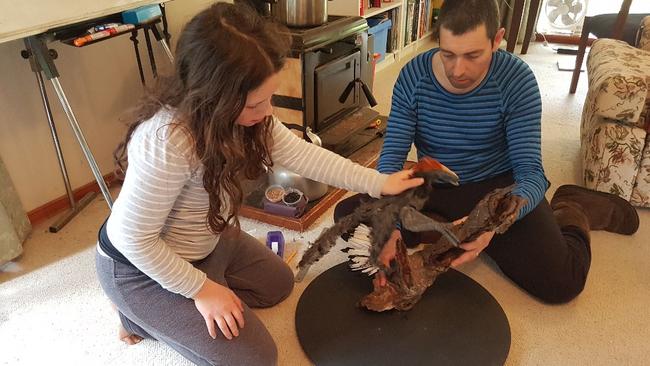Upper Sturt student Phoebe Wood made a model of Anchiornis huxleyi for the Oliphant Science Awards
Year 6 student Phoebe poured an incredible 400 hours into this super-realistic dinosaur sculpture, catching the eye of senior palaeontologists. See how she made it here.
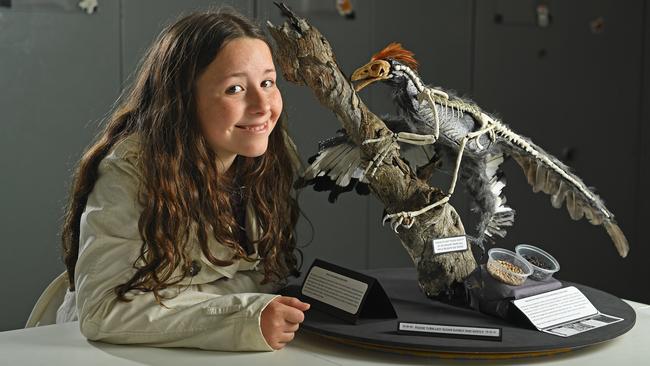
SA News
Don't miss out on the headlines from SA News. Followed categories will be added to My News.
Childlike wonder about the miracle of flight inspired Phoebe Wood, 11 of Aldgate to spend more than 400 hours creating a life size model of a prehistoric birdlike dinosaur for the state’s biggest school science competition.
Her model of the Mesozoic paravian has drawn praise from local palaeontologists at Flinders University and the South Australian Museum but the Year 6 student from Upper Sturt Primary School says it’s “nowhere near” what she had in mind.
“I wanted to make an animatronic Anchiornis huxleyi but it didn’t turn out that way,” she said.
“Now I’m studying the physics of flight and trying to figure out if I should try to do an invention or robotics, something that can actually fly.”
Her scientifically accurate model entry in the Oliphant Science Awards caught the eye of palaeontology entertainer Professor Flint (Michael Mills) who organised a lab tour.
In her own words:
MODELS AND INVENTIONS – Anchiornis huxleyi
by Phoebe Wood
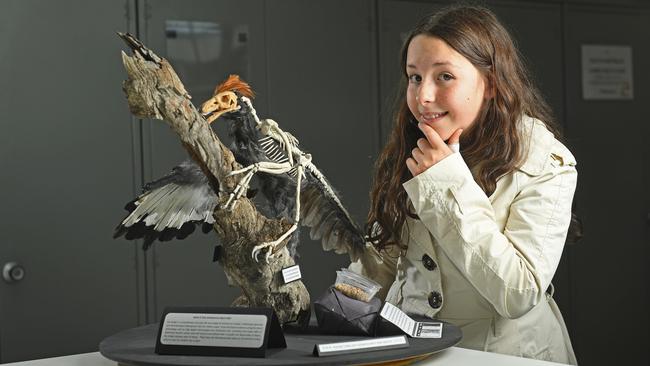
Scientific principle: My model is a scientifically accurate life size model of Anchiornis huxleyi, a Mesozoic paravian dating back 161-151 million years. From the fossil evidence using the latest technology such as high depth microscopes and ultraviolet rays, scientists have been able to determine feather colour and soft tissue musculature that is usually not discernible in fossils. My model displays both of these. They have not discovered eye colour in A. huxleyi which is why my model’s eye is clear.
Procedure: I spent over 400 hours extensively researching and crafting to make this life size model as accurate as possible. Using the latest scientific information, I created a double sided, life size sketch to base the model off. I shaped alfoil into a half body using the drawing as my guide. I cut and heated Worbla (heat mouldable plastic sheet) over the alfoil, then I made a socket for the arm, so it moves. I glued fabric to the Worbla then stuck feathers to it. For the skeleton side I made a wire armature. To shape the bones, I made homemade air-dry clay and formed each individual bone over the wire. I used latex on the face and feet then painted it.
MUM’S PHOTOGRAPHIC RECORD OF PHOEBE’S PROJECT
Photos and text by mother Jo Wood
Please note that all the work, ideas, processes involved in this project are entirely Phoebe’s. This photographic record does not count in any way towards the Oliphant Science Awards, it is only there as a record of how this creature was made if anyone is interested and for Phoebe’s own work record. The awards are only concerned with the model itself and the report which was written by Phoebe.
First it was drawn up to life size scale and double sided to show both sides of the animal.
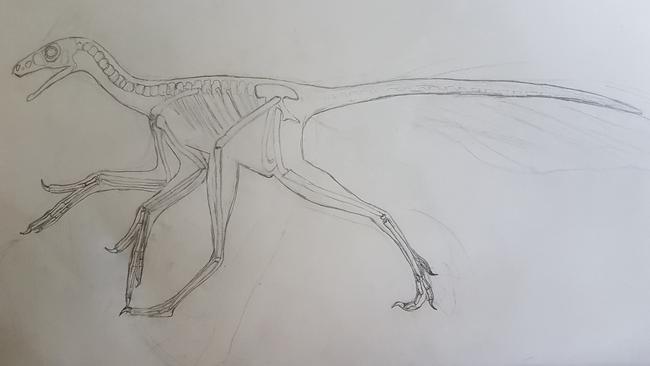
First attempts at paper structures, then papier mâché & even a plasticine mould. None worked effectively.
SA Moulding and Casting gave Phoebe some small samples of Worbla, which is heat mouldable thermoplastic sheeting. She made a skull out of it, first cutting out a cardboard template & decided it was the right product to use for her model.
She made a mould out of alfoil to shape the body, then cut Worbla roughly to shape & heated it & formed it over the mould
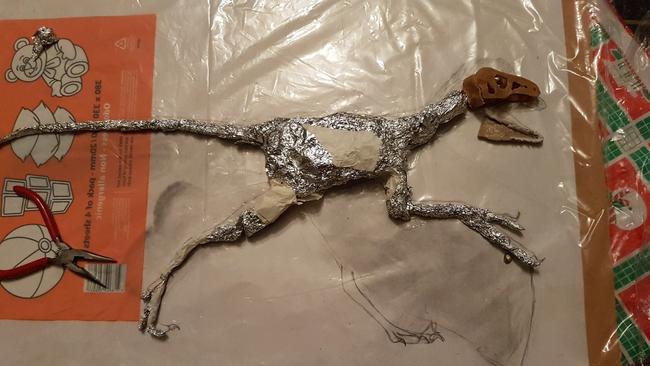
Heating the Worbla and shaping it. There was a bowl of water next to her so she didn’t burn her fingers.
Feather trial #1 - tried putting emu feathers into fleece fabric to see how it would look. The amount of feathers needed would be too much to collect easily and Phoebe said it was a harder look and feel than Anchiornis huxleyi was thought to have.
She made the arm have a ball and socket joint so it can move. The outside of the full body half is now formed.
Phoebe made a wire spine armature then made each individual vertebrae out of home-made air dry clay.
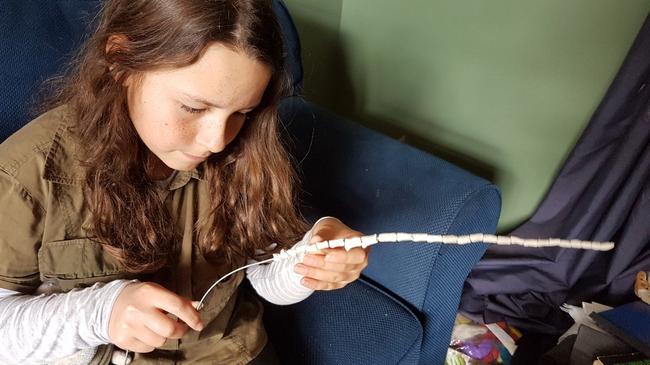
The ribs were made out of air dry clay for the vertebrae section then wire wrapped in masking tape for the ribs.
Phoebe used her life size drawing to check the measurements of all the skeleton parts. Then she added the wire armature for the arm and leg.
The arm wires were wrapped in black florist tape so you can’t see metal between the bones. Then the bones around the wire were formed with the home made air dry clay. She then checked that the arm would fit well on the log.
Working the arm and fingers.
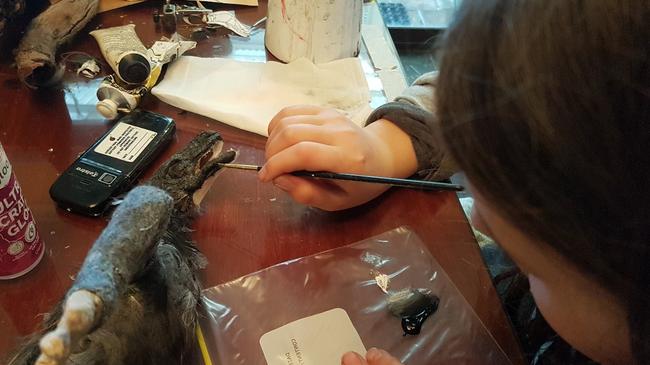
The skeleton side fits the log. Making the pelvis was tricky so she used a 3D image of a velociraptor model to help get the shape right, as well as the original picture by Scott Hartman, the paleoartist who drew the most accurate one so far. Phoebe sought out and received Scott’s permission via email to use his images.
Fur fabric was tried first but it was really hard to get the feathers in & to keep them sitting straight. The fabric was hard to work with, so Phoebe decided to glue fleece direct to the Worbla and then glue each individual feather on to that.
She sewed elastic onto the arm to form the patagium tendon and skin.
Laying out the feathers for the back leg and gluing each one in place.
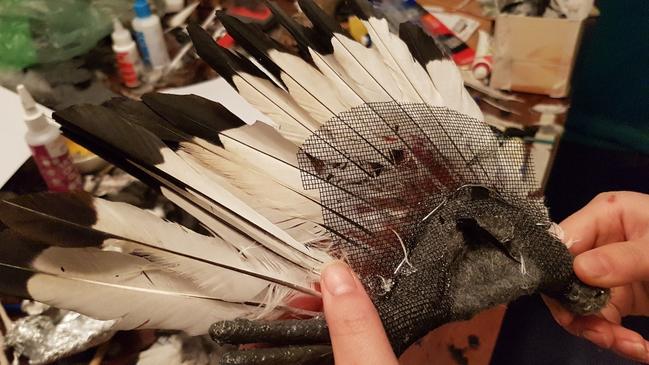
Practice building up the flesh with tissue and glue, latex and paint, then on to the real one.
Carefully painting, working on the detail to make the real one look like the practice one. Finally got his crest feathers in place too.
Making the melanosomes examples out of black rice and coriander seeds to resemble their appearance under an electron microscope.
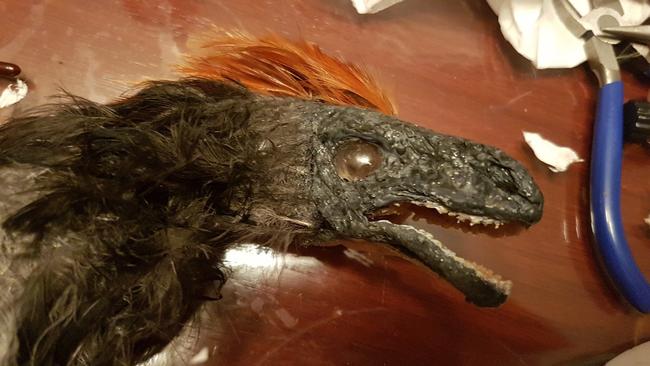
Then she padded out the sole of the foot, making sure each foot pad looks as real as possible.
It was tricky figuring out how to fill the hollow side so she could attach the skeleton side. Thick black foam was the final choice.
Dad filled the hollow bottom of the log so it could be drilled into to fasten to the lazy susan board. Together they tested where to put the log, then put the board between two tables and Dad drilled up while Phoebe held the log in place.
Working on the wing but with so many layers of feathers she had to support them with a bit of metal fly wire.
